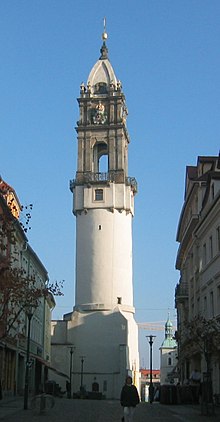Bautzen: Difference between revisions
No edit summary |
No edit summary |
||
| Line 46: | Line 46: | ||
|} |
|} |
||
'''Bautzen''' ([[International Phonetic Alphabet|pronounced]] {{IPA|[ˈbautsn̩]}}, [[Image:Ltspkr.png]] [[Media:Bautzen pronunciation in German.ogg|listen]], until [[1868]]: '''Budissin'''; [[Upper Sorbian language|Upper Sorbian]] '''Budyšin'''; [[Lower Sorbian language|Lower Sorbian]]: Budyšyn |
'''Bautzen''' ([[International Phonetic Alphabet|pronounced]] {{IPA|[ˈbautsn̩]}}, [[Image:Ltspkr.png]] [[Media:Bautzen pronunciation in German.ogg|listen]], until [[1868]]: '''Budissin'''; [[Upper Sorbian language|Upper Sorbian]] '''Budyšin'''; [[Lower Sorbian language|Lower Sorbian]]: '''Budyšyn''' ;[[Polish language|Polish]]: '''Budziszyn''' {{IPA|[buˈdʑiʃɨn]}}, [[Image:Ltspkr.png]] [[Media:Budziszyn.ogg|listen]]; [[Czech language|Czech]] '''Budyšín''') is a city in the east of [[Saxony]], [[Germany]], and capital of the [[Bautzen (district)|eponymous district]]. It is located on the [[Spree]] River. As of [[2003]], its population is 42,391. |
||
Bautzen may be regarded as the unofficial capital of [[Lusatia|Upper Lusatia]], and it is a cultural center of the [[Sorbs]], a [[Slavic peoples|Slavic]] minority. |
Bautzen may be regarded as the unofficial capital of [[Lusatia|Upper Lusatia]], and it is a cultural center of the [[Sorbs]], a [[Slavic peoples|Slavic]] minority. |
||
Revision as of 13:01, 17 June 2005
| Statistics | |
|---|---|
| State: | Saxony |
| Regierungsbezirk: | Dresden |
| District: | Bautzen |
| Area: | 66.63 km² |
| Population: | 42,333 (12/31/2002) |
| Population density: | 635/km² |
| Elevation: | 204 m |
| Postal code: | 02601-02625 |
| Area/distance code: | 03591 |
| Location: | 51°11′N 14°26′E / 51.183°N 14.433°E |
| Municipal code: | 14272010 |
| Car designation: | BZ
|
| Arrangement of the city: | 24 districts |
| Website: | www.bautzen.de |
Bautzen (pronounced [ˈbautsn̩], ![]() listen, until 1868: Budissin; Upper Sorbian Budyšin; Lower Sorbian: Budyšyn ;Polish: Budziszyn [buˈdʑiʃɨn],
listen, until 1868: Budissin; Upper Sorbian Budyšin; Lower Sorbian: Budyšyn ;Polish: Budziszyn [buˈdʑiʃɨn], ![]() listen; Czech Budyšín) is a city in the east of Saxony, Germany, and capital of the eponymous district. It is located on the Spree River. As of 2003, its population is 42,391.
listen; Czech Budyšín) is a city in the east of Saxony, Germany, and capital of the eponymous district. It is located on the Spree River. As of 2003, its population is 42,391.
Bautzen may be regarded as the unofficial capital of Upper Lusatia, and it is a cultural center of the Sorbs, a Slavic minority.
The first written proof of the city was in 1002. In 1018 the Peace of Bautzen was signed between the German king Henry II and the Polish prince Boleslaus I. The Treaty left Bautzen under the Polish rule. In 1033 the city passed to the Holy Roman Empire, in 1319 to Bohemia and in 1635 to Saxony. During the Middle Ages it was a member of the Six Cities' Alliance of the Upper Lusatian cities of Görlitz, Zittau, Löbau, Kamenz, Lauban and Bautzen.
During the Nazi era there was a subcamp of the Groß-Rosen concentration camp in Bautzen. Ernst Thälmann was imprisoned there before being deported to Buchenwald.
The East German regime kept a prison for opposition members in Bautzen. The prison was called Gelbes Elend ("Yellow Misery") by the people.
In 2002 the city commemorated its thousandth birthday.
Asteroid (11580) Bautzen is named in honor of the city.

Subdivisions:
Here are the subdivisions of Bautzen:
- In the east:
- Auritz
- Jenkwitz-West
- Strehla
- In the south:
- In the west:
- In the southwest:
Twin Cities

- Worms, since 1990
- Heidelberg, since 1991
- Dreux, France, since 1992
- Jablonec nad Nisou, Czech Republic, since 1993
- Jelenia Góra, Poland, since 1993
Sites of Interest:
There are four museums including the Stadtmuseum Bautzen (lit. the Bautzen city Museum) and the Sorbisches Museum, lit. the Sorbian Museum (Sorbian-Lusatian: Serbski muzej).
